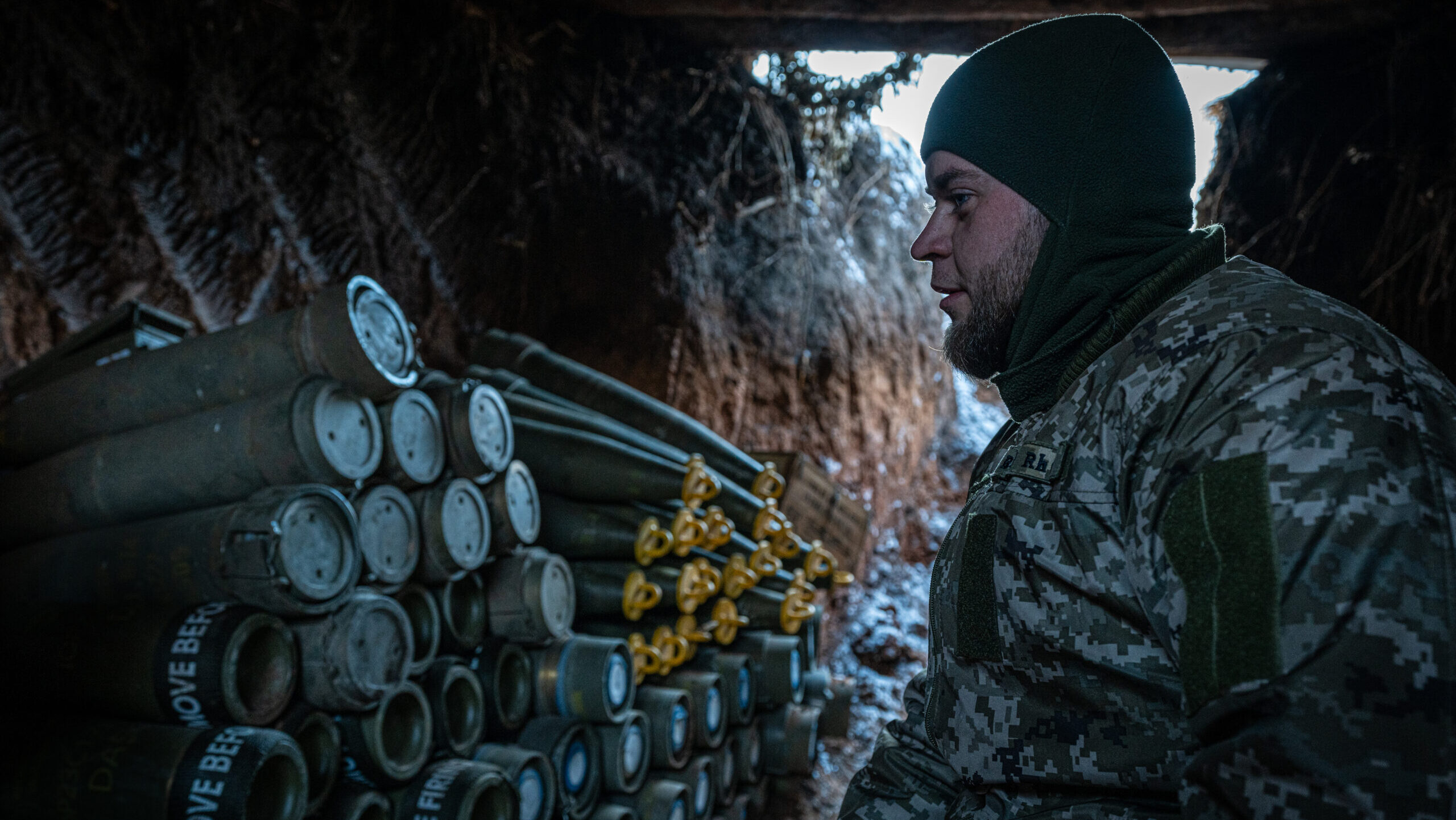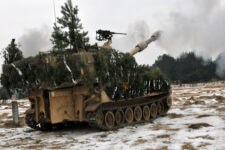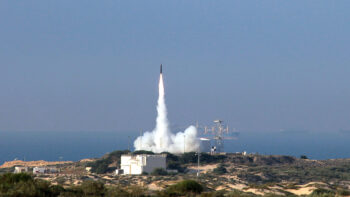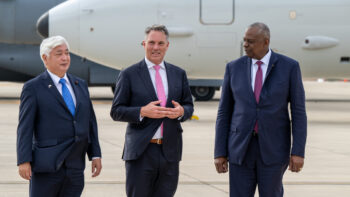
A Ukrainian soldier waits for orders near artillery shells for the M109 artillery self-propelled vehicle on the front line, in the direction of Bakhmut, where clashes between Russia and Ukraine continue to take place, in Donetsk Oblast, Ukraine on January 22, 2024. (Photo by Ignacio Marin/Anadolu via Getty Images)
EUROSATORY 2024 — Northrop Grumman plans to produce medium caliber ammunition inside Ukraine under a project bankrolled by Ukrainian dollars, a company official said today.
Although several European defense firms have committed to large-scale manufacturing programs inside Ukraine’s borders, Northrop’s coproduction agreement is the first publicly acknowledged deal between a US defense prime and the Ukrainian government for a manufacturing project inside Ukraine.
“We’ve been working, as you know, in Ukraine to produce medium [caliber munitions]. That’s our first project that’s paid for with Ukrainian dollars. We are looking to expand that into tank ammo, 155 mm, others as we find innovative processes,” said Dave Bartell, director of international business for Northrop’s defense systems sector.
The acknowledgment of the agreement occurred during an exchange between Bartell and Stanley Brown, the State Department’s principal deputy assistant secretary for the bureau of political-military affairs, during Brown’s speech at the Eurosatory arms show in Paris.
Bartell did not elaborate on the coproduction plan, and Northrop declined to comment for this story.
In his remarks, Brown highlighted the State Department’s new Ukraine Defense Enterprise Program, which invests $2 billion in Ukraine’s defense industrial base and could open the door to US-Ukrainian coproduction.
“What would incentivize your company to partner with Ukraine on defense coproduction?” Brown asked the industry crowd gathered at the conference. “As we look to build a more robust defense industrial base, American industry is essential. So how do we set the conditions for help to help you be successful?”
In response, Bartell grabbed the microphone to describe Northrop’s efforts to produce munitions inside Ukraine. He then added that while the company understands the importance of reconstituting Ukraine’s defense industrial base, it has encountered barriers when it has tried to offer the latest version of certain weapons, which are typically cheaper and easier to produce.
“As we answered US Army and DoD contracts for 155mm rounds, for example, there are very specific TDPs [technical data packages],” he said. “Right now, my company has built a better mousetrap, we would prefer to take that generational leap in technology and put that in there. But if we work under US Army regulations and qualifications, we’re going to be doing legacy systems that are expensive, and take a long time to produce.”
Brown deferred to the Army on specific technical requirements, but responded that the US government is open to outside-the-box approaches to meeting Ukraine’s needs.
“We are way more open minded than probably we have been,” he said. “Sometimes it doesn’t look that way because of the bureaucratic problems, but we’re happy to have those discussions on the entrepreneur-like and innovative approaches.”
Building Production Inside Ukraine
US defense firms have lagged behind their European counterparts in forging coproduction agreements inside Ukraine. Earlier this month, Germany’s Rheinmetall acknowledged plans to open a Lynx Infantry Fighting Vehicle manufacturing plant in Ukraine “in the near future” and said it is in talks with Ukrainian suppliers on a new joint venture for in-country production of artillery ammunition.
Also this month, Franco-German manufacturer KNDS and Ukrainian firm KZVV signed a contract for production in Ukraine of 155mm artillery shells.
Earlier US coproduction efforts to support Ukrainian needs typically centered on efforts to produce US weaponry within the borders of NATO allies in Eastern Europe — such as a 2023 deal between Lockheed Martin and Raytheon to build Javelin anti-tank missiles in Poland — and stopped short of manufacturing arms inside Ukraine, which would be considerably more vulnerable to attack by Russia.
However, in recent months, the US government has stepped up efforts to work directly with Ukraine’s defense sector. In December, the White House held a Ukraine Defense Industrial Base Conference that included 350 representatives from the US and Ukrainian governments along with their respective defense industries, which resulted in the countries signing a Statement of Intent on Co-production and Technical Data Exchange to address Ukraine’s urgent needs on munitions production, air defense systems, and repair and sustainment.
The Ukraine Defense Enterprise Program program, which was announced in May, will draw from Foreign Military Financing dollars in the $60.8 billion Ukraine supplemental funding bill passed in April, as well as funding from previous defense budgets, Inside Defense reported.
And last week, President Joe Biden and Ukrainian President Volodymyr Zelenskyy signed a bilateral agreement espousing the need for “defense industrial cooperation, including codevelopment, coproduction, and supply of Ukraine’s defense industrial base requirements.”
Ashley Roque in Paris contributed to this report.






















